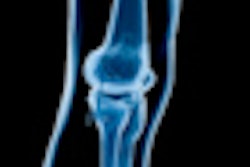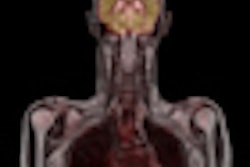Three-dimensional fast spin-echo MRI can achieve "moderate to almost perfect agreement and high accuracy" compared with routine 2D fast spin-echo MRI for evaluating knee osteoarthritis, but in 30% less time, according to a study presented at the recent RSNA 2011 meeting in Chicago.
Researchers from the U.S., Germany, and Brazil collaborated on the study, in which semiquantitative, whole-joint assessment of knee osteoarthritis with 3D fast spin-echo MRI was performed for the first time in osteoarthritis research, they said.
"3D fast spin-echo MRI has the advantage of shorter acquisition time with comparable image quality, when we compared it to routine 2D fast spin-echo sequences that we use in clinical practice," said lead study author Dr. Michel Crema from the Quantitative Imaging Center at Boston University School of Medicine and the Institute of Diagnostic Imaging at the University of São Paulo.
3D fast spin-echo MRI "also has the advantage of the possibility of reformation in any given plane, and has the advantage of high-resolution compared to routine 2D fast spin-echo MRI," he added.
Crema and colleagues recruited 20 subjects older than age 40 and evaluated one knee per subject using the American College of Rheumatology clinical standard for osteoarthritis. The individuals received both routine 2D and 3D fast spin-echo MRI techniques on the same day, with both exams performed on a 1.5-tesla system (Achieva, Philips Healthcare).
Routine 2D fast spin-echo MRI was performed with triplanar (axial, sagittal, and coronal) fat-suppressed, intermediate-weighted fast spin-echo sequences. The total time of acquisition for the three 2D fast spin-echo sequences was eight minutes, 13 seconds. The 3D fast spin-echo fat-suppressed MRI exams were obtained using the sagittal planes for source images, with a total acquisition time of five minutes.
Two radiologists separately and independently evaluated the 2D and 3D fast spin-echo MRI results, with a time interval between readings of one month. To further evaluate the efficacy of the two MRI techniques, the researchers divided the knee images into 15 different subregions.
The evaluations of both MR imaging techniques included cartilage morphology, meniscal morphology, osteophytes, meniscal extrusion, bone marrow lesions, and subchondral and periarticular cysts. The researchers then calculated the intrareader and interreader reliability of both radiologists' results in all categories.
Intrareader reliability between 2D and 3D fast spin-echo MRI was greatest for meniscal extrusions, with a value of 0.94, which is "almost perfect agreement," Crema said. The lowest reliability value was 0.62 for osteophytes, which, he added, still shows "substantial agreement" between the readers.
For interreader reliability, the lowest value was 0.42 for bone attrition, which was considered only moderate agreement. The highest value was 0.83 for meniscal extrusion, which Crema described as "substantial agreement."
As for diagnostic performance between 2D and 3D fast spin-echo MRI, sensitivity values were lowest (80%) for bone attrition and cartilage morphology (81%). Three categories -- meniscal morphology, subchondral cysts, and periarticular cysts -- achieved sensitivity of 100%.
Specificity was 100% for joint effusion and meniscal extrusion, while the lowest specificity was 62% for osteophytes. The greatest accuracy was achieved for subchondral cysts, at 99%, followed by bone attrition at 98% and meniscal morphology at 90%. The lowest accuracy rate was 77% for osteophytes.
Based on the results, 3D fast spin-echo MRI "is a reliable technique for semiquantitative assessment of knee osteoarthritis," Crema and colleagues concluded. "We had moderate to almost perfect agreement and high accuracy for 3D fast spin-echo MRI compared to routine 2D fast spin-echo MRI."
3D fast spin-echo MRI also has the advantage of faster image acquisition by approximately 30% over 2D fast spin-echo MRI, which is "of relevance, especially for large osteoarthritis studies," Crema added.




















